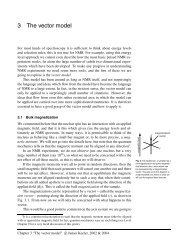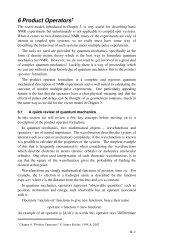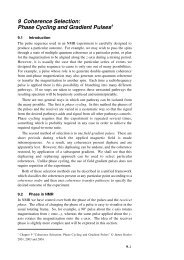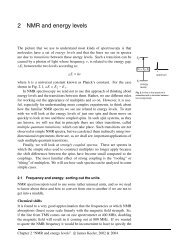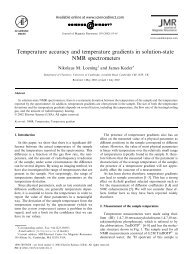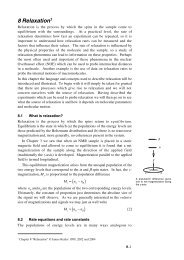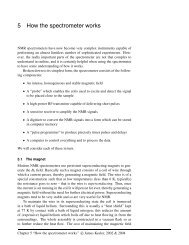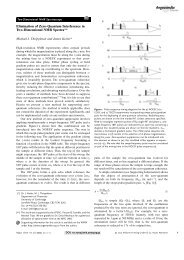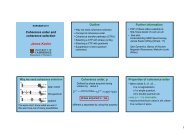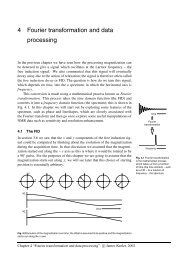Phase Cycling and Gradient Pulses - The James Keeler Group
Phase Cycling and Gradient Pulses - The James Keeler Group
Phase Cycling and Gradient Pulses - The James Keeler Group
You also want an ePaper? Increase the reach of your titles
YUMPU automatically turns print PDFs into web optimized ePapers that Google loves.
y<br />
y<br />
180°(±x)<br />
τ<br />
90°(x) – τ<br />
–x<br />
x<br />
–y<br />
180°(±y)<br />
τ<br />
If the phase of the 180° pulse is +x or –x the echo forms along the y-axis,<br />
whereas if the phase is ±y the echo forms on the –y axis. <strong>The</strong>refore, as the 180°<br />
pulse is advanced by 90° (e.g. from x to y) the receiver must be advanced by<br />
180° (e.g. from x to –x). Of course, we could just as well cycle the receiver<br />
phases y, –y, y, –y; all that matters is that they advance in steps of 180°. We<br />
will see later on how it is that this phase cycle cancels out the results of<br />
imperfections in the 180° pulse.<br />
–y<br />
I<br />
S<br />
1<br />
2J<br />
y<br />
1<br />
2J<br />
Pulse sequence for INEPT.<br />
Filled rectangles represent 90°<br />
pulses <strong>and</strong> open rectangles<br />
represent 180° pulses. Unless<br />
otherwise indicated, all pulses<br />
are of phase x.<br />
9.2.8 Difference spectroscopy<br />
Often a simple two step sequence suffices to cancel unwanted magnetization;<br />
essentially this is a form of difference spectroscopy. <strong>The</strong> idea is well illustrated<br />
by the INEPT sequence, shown opposite. <strong>The</strong> aim of the sequence is to transfer<br />
magnetization from spin I to a coupled spin S.<br />
With the phases <strong>and</strong> delays shown equilibrium magnetization of spin I, I z<br />
, is<br />
transferred to spin S, appearing as the operator S x<br />
. Equilibrium magnetization<br />
of S, S z<br />
, appears as S y<br />
. We wish to preserve only the signal that has been<br />
transferred from I.<br />
<strong>The</strong> procedure to achieve this is very simple. If we change the phase of the<br />
second I spin 90° pulse from y to –y the magnetization arising from transfer of<br />
the I spin magnetization to S becomes –S x<br />
i.e. it changes sign. In contrast, the<br />
signal arising from equilibrium S spin magnetization is unaffected simply<br />
because the S z<br />
operator is unaffected by the I spin pulses. By repeating the<br />
experiment twice, once with the phase of the second I spin 90° pulse set to y<br />
<strong>and</strong> once with it set to –y, <strong>and</strong> then subtracting the two resulting signals, the<br />
undesired signal is cancelled <strong>and</strong> the desired signal adds. It is easily confirmed<br />
that shifting the phase of the S spin 90° pulse does not achieve the desired<br />
separation of the two signals as both are affected in the same way.<br />
In practice the subtraction would be carried out by shifting the receiver by<br />
180°, so the I spin pulse would go y, –y <strong>and</strong> the receiver phase go x, –x. This is<br />
a two step phase cycle which is probably best viewed as difference<br />
spectroscopy.<br />
This simple two step cycle is the basic element used in constructing the<br />
9–8



